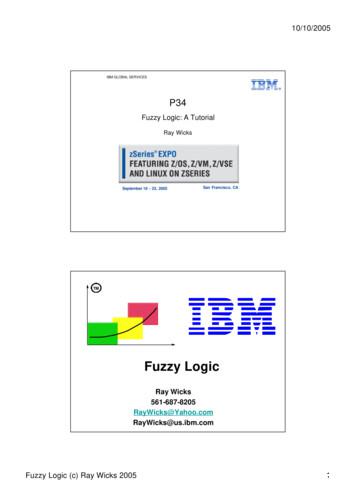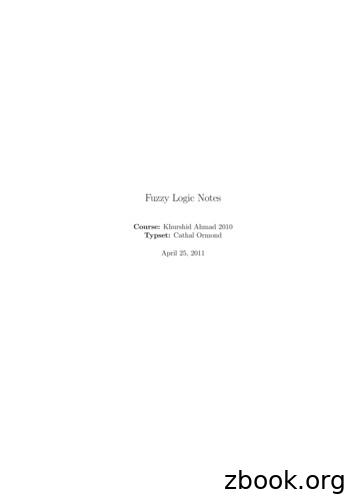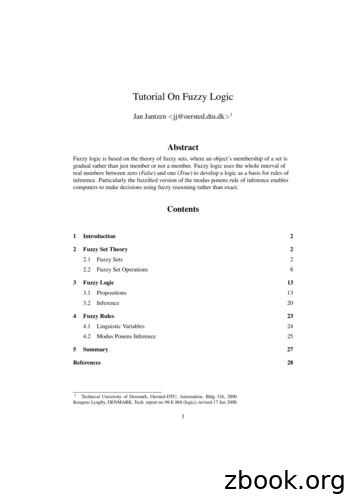Fuzzy Logic - VM
10/10/2005IBM GLOBAL SERVICES P34Fuzzy Logic: A TutorialRay WicksSeptember 19 - 23, 2005San Francisco, CATMFuzzy LogicRay .comFuzzy Logic (c) Ray Wicks 20051
10/10/2005AbstractFuzzy Logic: A tutorialIn a course in switching theory or traditional symbolic logic,one studies a form of logic which has existed from theearly Greeks, notably Aristotle. This session reviews theprinciples of this crisp symbolic logic (negation, and, or, ifthen, etc.) and then proceeds to introduce Fuzzy logic andFuzzy sets. This new logic has interesting ramifications infuzzy thinking and neural networks. An example usingfuzzy rules in a control system will be introduced. You don’tneed a logic background for this session.Ray WicksIndependent ConsultantRayWicks@Yahoo.comBackgroundEveryone in their own mind thinks of themselves aslogical, clear thinking and free from bias.In the middle ages, logic was taught as a method ofarriving at correct answers from acceptedassumptions. Metaphysics provided the unassailableassumptions. The approach was impeccable.However, semantics of actual language is not binary(black and white) but fuzzy (shades of grey). Theintroduction of fuzziness into logic creates havocamong logicians but brings logic closer to every dayusage.Fuzzy Logic (c) Ray Wicks 20052
10/10/2005Crisp DefinitionsNot PP P0110P or QP0011Q PvQ00110111P and QP0011Q P?Q00100011If P then QP0011Q P? Q01110011Game RulesPSSzzFuzzy Logic (c) Ray Wicks 2005QSzSzP*QSzzz3
10/10/2005Crisp DefinitionsP is equivalent to QP0011P Excl or QQ PhQ01100011P? Q.? .Q? PP0011Q PIQ00110110PI Q P? Q.v. P? QOrPI Q (P h Q)Reduction a la RussellUsing “ ” “is incompatible with” or“not both”P Stroke QP0011Q P Q01110110Fuzzy Logic (c) Ray Wicks 2005 P P PPvQ P QP?Q (P Q)P? Q P Q4
10/10/2005ObscuritiesIf p or q and If q Then r, Then p or r.((pvq) ? (q? r)) ? (pvr)pvq.?.q? r:? :pvrCKApqCqrAprTruth Analysis – A Gamev 0 10 0 11 1 1? 0 10 0 01 0 1? 0 10 1 11 0 1PVQq 1vQ replace with 1q 0vQ replace with Qq P?Qq 1?Q replace with Qq 0?Q replace with 0q P? Qq P? 0 replace with Pq P ? 1 replace with 1q 1 ? Q replace with Qq 0 ? Q replace with 1qFuzzy Logic (c) Ray Wicks 20055
10/10/2005Truth Analysis (Crisp)If p or q Then p and q1pvq :? : p? qp10Truth(1vq) .? . 1 ? q(0vq) .? . 0 ? q1 .? . qq .? . 0q q1000p1qLogical DeductionModus PonensdP? QdP‹QP? QorPQIf I eat candy, my blood sugar will riseI ate candyMy blood sugar is elevatedFuzzy Logic (c) Ray Wicks 20056
10/10/2005Logical DeductionModus TollensP? Q Q PIf I eat candy, my blood sugar will riseMy blood sugar is not elevatedI did not eat candyLogical DeductionModus Tollendo PonensPvQ PQI took a walk or my blood sugar is elevatedMy blood sugar is not elevatedI took a walkNote: In symbolic logic, the sentences (p,q) need not be semantically linked.Fuzzy Logic (c) Ray Wicks 20057
10/10/2005Logical FallaciesFallacy of Affirming the ConsequentP? QQPIf I eat candy, my blood sugar will riseMy blood sugar is elevatedI must have eaten candyQuantitative & Visual LogicSx.Ax v BxABx x xFor some x, x has property A orx has Property BPx.Bx CxFor all x, if x has property B thenrx has Property CSx.Ax v CxFor some x, x has property A orx has Property CFuzzy Logic (c) Ray Wicks 2005CAxBCxx xooBoACx x x8
10/10/2005Semantic Evaluation of a CSConsistent - Nothing Logically absurd orself contradictory in meaning shall be atheorem, or that there shall not be twotheorems of which one is the negation of theother. (p v p is not a theorem).q Complete – Roughly, the system shall haveall possible theorems not in conflict with theinterpretation. (You can prove what you wantto prove.)q Simpleq Pragmaticq VerifiableqPhilosophical .780.770.760.750.74y -0.0002x 8.2996R2 0.4388(LightsUp)ContextIn reaching a conclusion, we negotiate between thepotential perceptual structures and the potentialconceptual structures and memory events.Fuzzy Logic (c) Ray Wicks 20059
10/10/2005Our Perception is Fuzzy.Is Our Thinking Fuzzy?30002500CS MB.20001500y 2.1054x 2383.72R 0.0119100050000510152025CPU%Our Perception is Fuzzy.Is Our Thinking Fuzzy?27002600CS MB.2500240023002200y 2.1054x 2383.7R2 0.0119210020000510152025CPU%Fuzzy Logic (c) Ray Wicks 200510
10/10/2005Paradox: P v P ?The Liar: ‘A man says he is lying. Is what hesays true or false?’The heap: If you have a heap of sand andremove one grain at a time, when does it ceaseto be a heap?Parking: If you park in a parking lot and do notpark exactly in the space between the lines, areyou parked in the space or not?In Ordinary LanguageC: “How’s the wine?”F: “Pretty good.”C: “How’s the cheese?”F: “Not bad.”C: “Isn’t anything ever just good or badwith you?”F: “Sometimes.”Fuzzy Logic (c) Ray Wicks 200511
10/10/2005Can Truth Be a Matter of Degree?Tall?Truth10012345678FeetIf the rule is Tall 6’, what about 5.99’? 5.95’?. One gets the feeling thatthe rule is not necessarily crisp since even the measurement is itselffuzzy.Can Truth Be a Matter of 45678FeetTo represent the Fuzzy rule, a non binary function is available which does not yieldeither 0 or 1 but a value on the interval [0,1]. Can you stand something being notnecessarily true or false?Fuzzy Logic (c) Ray Wicks 200512
10/10/2005Hedge Words“Joe Montana always came through in the clutch.”Hedge WordAvgMinMaxAlways98.0895100Very often87.157095Rather ntly72.545087Generally71.926085About as often as not 46.54550Sometimes40.772060Occasionally36.151565Now and then31.54545Once in a while27.08560Not often22.671035Usually not19.69640Seldom16.92830Rarely13.23330Almost never12.69285Hardly ever11.23130Very 0.5411.7360.650.4551.526Fuzz is Not ProbabilityIn probability you deal withfrequencies of events. When youthrow a pair of dice, the probabilityof getting a 2 is 1 in 36. You will getone of the values.In fuzzy you deal with degrees.When you fill a glass ¾ full, is it fullor not? Yes to 0.75 degree.Fuzzy Logic (c) Ray Wicks 200513
10/10/2005Fuzzy LogicP,Q e {0,1}P,Q e [0,1]P P01Not P 1-P10 0.7 0.3P0011Q PvQ0 01 10 11 1PvQ Max(P,Q)0.3 V 0.75 0.75Fuzzy LogicP,Q e {0,1}P,Q e [0,1]P0011Q P? Q00100011P?Q Min(P,Q)P0011Q P? Q01110011P? Q (P? Q)Fuzzy Logic (c) Ray Wicks 20050.7?0.3 0.3 P v Q Max(1-P,Q)0.75 ? 0.5 0.514
10/10/2005Truth Analysis (Fuzzy)If p or q Then p and 6qNote: the corners match the crisp version.Crisp SetJust Right Response Time [40,65]10.80.60.40.202030Fuzzy Logic (c) Ray Wicks 2005405060708015
10/10/2005Fuzzy SetJust Right Response Time 080Crisp Just RightJust Right Just Right110.80.80.60.60.40.40.20.20020304050Fuzzy Logic (c) Ray Wicks 20056070802030405060708016
10/10/2005Fuzzy Just RightJust Right Just 04050607080Fuzzy Just Right and JR10.80.6 Just RJust R0.40.202030Fuzzy Logic (c) Ray Wicks 2005405060708017
10/10/2005Fuzzy Rules For Response TimeRule 1: If too short, lower priority a lot.Rule 2: If short, then lower priority a bit.Rule 3: If just right, then leave priority unchanged.Rule 4: If long, then raise priority a bit.Rule 5: If very long, then raise priority a lot.Graph of Fuzzy Rules1Too ShortShort0.80.6Just Right0.4LongVery Long0.20405060708090100Response Time10.80.60.40.20Lower a lotLower a bitUnchange0204060PriorityFuzzy Logic (c) Ray Wicks 200580100Raise a bitRaise a lot18
10/10/2005Hedge for Response 63At 6310.80.60.40.20405060708090100Too ShortShortJust RightLongVery LongR Just RightR ShortResponse TimeResponse Rules Fire10.80.6Lower a bitUnchange0.40.20020406080100PriorityFuzzy Logic (c) Ray Wicks 200519
10/10/2005Add Rule Output10.8Lower a ify the tyFuzzy Logic (c) Ray Wicks 200520
10/10/2005ProcessRule: If Ai then BiRule: If Ai then BiInput ARule: If Ai then Bi BDefuzzifierCRule: If Ai then BiApplicationsFuzzy Logic (c) Ray Wicks 200521
112.9102.5Fuzzy StatisticsT-Test @ 0.05t-Test: Two-Sample Assuming Unequal VariancesMeanVarianceObservationsHypothesized Mean Differencedft StatP(T t) one-tailt Critical one-tailP(T t) two-tailt Critical two-tailVariable 1 Variable 2134.49 125.005231.5271 91673What about 0.06? 0.08? 0.025?Fuzzy Cognitive Maps“Fuzzy cognitive maps (CFMs) are fussy signed directedgraphs with feedback. The directed edge eij from causalconcept Ci to concept Cj measures how much Ci causesCj. The time-varying concept Ci(t) measures thenonnegative occurrence of some fuzzy event.” [Kosko 2]C1 C2Fuzzy Logic (c) Ray Wicks 2005 C322
10/10/2005Fuzzy Cognitive MapsC1 FootballC1C2 Alcohol ConsumptionC3 Raised TestosteroneC4 Competitive NatureC2C5 Respect for WomenC3C6 Long Term RelationshipC4C7 Practical JokesC8 Video GamesC5C6C7C8Created by Daniel Adams for UMD Honors Seminar, 1999C1 FootballCFM ComputationsAlways 1C2 Alcohol ConsumptionC3 Raised TestosteroneUsually 0.8C4 Competitive NatureFrequently 0.6C5 Respect for WomenSometimes 0.4C6 Long Term RelationshipRarely 0.2C7 Practical JokesNever 0C8 Video 001.611.610000000Fuzzy Logic (c) Ray Wicks 2005C80000.80000000 DeFuzzify0.81 DeFuzzify0.81 DeFuzzify23
10/10/2005Fuzzy Cognitive MapsC1 FootballC1C2 Alcohol ConsumptionC3 Raised TestosteroneC4 Competitive NatureC2C5 Respect for WomenC3C6 Long Term RelationshipC4C7 Practical JokesC8 Video GamesC5C6C7C8Created by Daniel Adams for UMD Honors Seminar, 1999CFMC1 Weight LossC1C2 Healthy DietC7C3 Not SmokingC4 Avoiding AlcoholC2C5 ExerciseC3C6 Decreased StressC5C7 Increased EnergyC6C4Created by Ellen Tallerico for UMD Honors Seminar, 1999Fuzzy Logic (c) Ray Wicks 200524
10/10/2005CFM ComputationsC1 Weight LossC2 Healthy DietC3 Not SmokingC1C2C5 ExerciseC3C6 Decreased Stress C4C7 Increased Energy 10.711.212.111.61C4 Avoiding AlcoholCFMC1 Weight LossC1C2 Healthy DietC7C3 Not SmokingC4 Avoiding AlcoholC2C5 ExerciseC3C6 Decreased StressC5C7 Increased EnergyC6C4Created by Ellen Tallerico for UMD Honors Seminar, 1999Fuzzy Logic (c) Ray Wicks 200525
10/10/2005Bibliography1. Fuzzy Thinking: The New Science of Fuzzy Logic, BartKosko, Hyperion, 1993, A popular Introduction.2. Neural Networks and Fuzzy Systems, Bart Kosko, PrenticeHall, 1992, A technical approach.3. Fuzzy Logic for Business and Industry, Earl D. Cox,Charles River Media, 1995, Applications withimplementations.4. Fuzzy Logic: The Revolutionary Computer TechnologyThat is Changing the World, Daniel McNeill & PaulFreiberger, Simon & Schuster, 1993, Some Logic and somephilosophy.5. Elementary Logic, W.V. Quine , Harvard, 1980, Good Intro toLogic.Fuzzy Logic (c) Ray Wicks 200526
Fuzzy Logic: A tutorial In a course in switching theory or traditional symbolic logic, one studies a form of logic which has existed from the early Greeks, notably Aristotle. This session reviews the principles of this crisp symbolic logic (negation, and, or, if - then, etc.) and then proceeds to introduce Fuzzy logic and Fuzzy sets.
2.2 Fuzzy Logic Fuzzy Logic is a form of multi-valued logic derived from fuzzy set theory to deal with reasoning that is approximate rather than precise. Fuzzy logic is not a vague logic system, but a system of logic for dealing with vague concepts. As in fuzzy set theory the set membership values can range (inclusively) between 0 and 1, in
ing fuzzy sets, fuzzy logic, and fuzzy inference. Fuzzy rules play a key role in representing expert control/modeling knowledge and experience and in linking the input variables of fuzzy controllers/models to output variable (or variables). Two major types of fuzzy rules exist, namely, Mamdani fuzzy rules and Takagi-Sugeno (TS, for short) fuzzy .
Fuzzy Logic IJCAI2018 Tutorial 1. Crisp set vs. Fuzzy set A traditional crisp set A fuzzy set 2. . A possible fuzzy set short 10. Example II : Fuzzy set 0 1 5ft 11ins 7 ft height . Fuzzy logic begins by borrowing notions from crisp logic, just as
fuzzy controller that uses an adaptive neuro-fuzzy inference system. Fuzzy Inference system (FIS) is a popular computing framework and is based on the concept of fuzzy set theories, fuzzy if and then rules, and fuzzy reasoning. 1.2 LITERATURE REVIEW: Implementation of fuzzy logic technology for the development of sophisticated
A Short Fuzzy Logic Tutorial April 8, 2010 The purpose of this tutorial is to give a brief information about fuzzy logic systems. The tutorial is prepared based on the studies [2] and [1]. For further information on fuzzy logic, the reader is directed to these studies. A fuzzy logic system (FLS) can be de ned as the nonlinear mapping of an
Tutorial On Fuzzy Logic Jan Jantzen 1 Abstract Fuzzy logic is based on the theory of fuzzy sets, where an object’s membership of a set is gradual rather than just member or not a member. Fuzzy logic uses the whole interval of real numbers between zero (False) and one (True) to develop a logic as a basis for rules of inference.
Fuzzy logic versus neural networks The idea of fuzzy logic is to approxi-mate human decision-making using nat-ural-language terms instead of quantita-tive terms. Fuzzy logic is similar to neur-al networks, and one can create behav-ioral systems with both methodologies. A good example is the use of fuzzy logic for automatic control: a set of .
Fuzzy logic has two different meanings. In a narrow sense, fuzzy logic is a logical system, which is an extension of multivalued logic. However, in a wider sense fuzzy logic (FL) is almost synonymous with the theory of fuzzy sets, a theory which relates to classes of objects with unsharp boundaries in which membership is a matter of degree. In .























